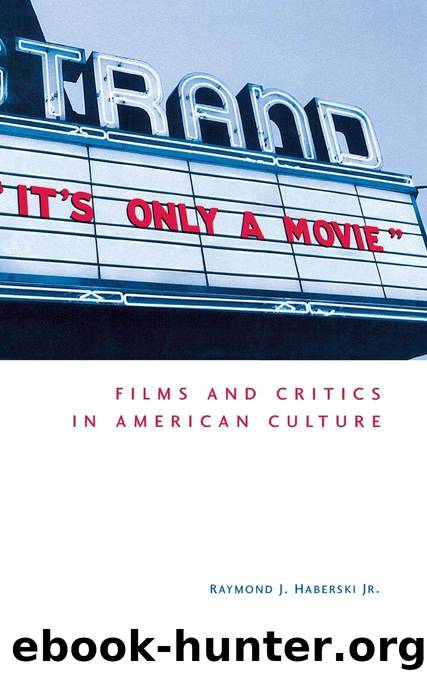It's Only a Movie! by Haberski Jr. Raymond J

Author:Haberski, Jr., Raymond J. [Haberski, Jr., Raymond J.]
Language: eng
Format: epub, azw3
ISBN: 9780813185217
Publisher: The University Press of Kentucky
Published: 2021-10-21T04:00:00+00:00
7
Andrew Sarris, Pauline Kael, and the Duel for the Soul of Criticism
American essayist Phillip Lopate remembers that as a nineteen-year-old student his passion for films ran very strong. In 1963 he agreed to run a film society at Columbia University and needed a way to justify his selections to a crowd of cinema enthusiasts. Lopate discovered his holy grail in the work of film critic Andrew Sarris. Sarris âseemed to cherish movies because they spoke to oneâs half-buried desires,â Lopate recalls fondly, âbut then cherished most those with an âadultâ (one of Sarrisâs favorite words) perspective, which acknowledged the necessity for sacrifice, whether gallant or otherwise.â Sarris was gallant and Lopate was smitten with him. For a slightly awkward college student with desires that tended toward the adolescent instead of the âadult,â discovering a kindred spirit in Sarris allowed Lopate to embrace movies in ways that seemed both intellectually daring and systematic. That effect on moviegoers underscored Sarrisâs unique style of criticism and sparked his meteoric rise to fame.1
By his own admission, Sarris was surprised and unprepared for such a reception. In the mid-1950s, Sarris had himself been a graduate student in English at Columbia University. In 1958, however, his life, somewhat like Lopateâs, was changed by the movies. Eugene Archer, a friend of Sarrisâs and fellow future movie critic, received a Fulbright Fellowship to study in Paris. Archer began spending an inordinate amount of time with the cinema radicals who gathered at the Cinémathèque Française and who wrote for Cahiers du Cinema. In letters he sent back to Sarris, Archer recounted discussions he had with this group about long-forgotten Hollywood directors. Intrigued, Sarris began reading the French film journal and was somewhat overwhelmed by the audacity of the French critics in treating Hollywood movies and directors with respect typically reserved for art and artists.2
Exposure to this criticism affected Sarris deeply. He writes, âa long sojourn in Paris in 1961 reassured me that film not only demanded but deserved as much faith as did any other cultural discipline.â Indeed, Sarris had experienced a religious conversion of sorts, remarking that he came to accept âthe sacred importance of the cinema.â But his new faith had made him, happily, ânot merely a cultist but a subversive cultist with a foreign ideology.â The element of foreignness was vital to Sarrisâs attraction to the French approach and the attractiveness of his own approach among movie enthusiasts in the United States. Rather than remain on the fringes of American movie culture, however, Sarris moved into the center of debates over criticism, taking his craft from the shadows of disrespect into the spotlight of popular relevance.
Two other trends also contributed to Sarrisâs rapid rise. First, just as he began publishing his first pieces of criticism using the auteur theory (as it came to be known), the French New Wave had begun to break over the United States. As Sarris remembers, âby the time the 1959 Cannes Film Festival introduced The 400 Blows, by a twenty-nine-year-old stormy
Download
This site does not store any files on its server. We only index and link to content provided by other sites. Please contact the content providers to delete copyright contents if any and email us, we'll remove relevant links or contents immediately.
It's Only a Movie! by Haberski Jr. Raymond J(178)
The Garden in the Machine by Unknown(153)
Euro-Visions: Europe in Contemporary Cinema by Mariana Liz(148)
The Greatest Show on Earth by Jerry Pinto(145)
Jafar Panahi: Interviews by Unknown(136)
Film and the Nuclear Age by Toni A. Perrine(128)
The Fellowship of the Knits: Lord of the Rings: The Unofficial Knitting Book by Tanis Gray(111)
RKO Radio Pictures Horror, Science Fiction and Fantasy Films, 1929-1956 by Michael R. Pitts(102)
THE GOLDEN AGE OF EROTIC CINEMA: 1959-1972 by Wiilliam Rotsler(102)
Horror Film by Murray Leeder(100)
Offbeat (Revised & Updated) by Julian Upton;(91)
The Last Interview by Nora Ephron(85)
Chinese films in focus II by Unknown(85)
Tuitions and Intuitions by William Rothman;(83)
Red, Blue, and Bronze: Inside the Symbols of the Wonder Woman Film by Frankel Valerie Estelle(82)
June Allyson: Her Life and Career by Peter Shelley(80)
Horror Films FAQ: All That's Left to Know About Slashers, Vampires, Zombies, Aliens, and More by John Kenneth Muir(77)
Last Stands from the Alamo to Benghazi by Frank Wetta Martin Novelli(77)
The Essential Humphrey Bogart by Constantine Santas(75)
